Top 10 Things to See in Cusco: What is Cusco Best Known For?

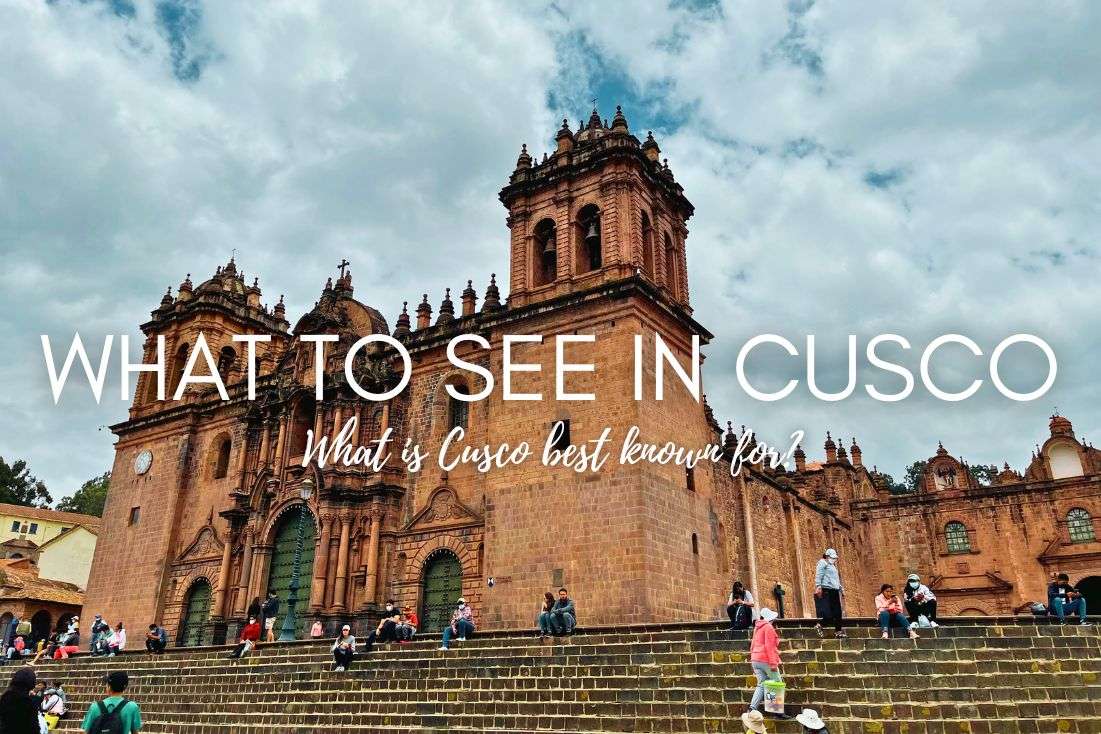
A list of the top things to see in Cusco: The must-sees of Cusco
Cusco map of things to see: It’s all very close together
My top tips for visiting Cusco:
Where to stay in Cusco? Choose an international hotel chain
1. Inca Museum (Museo Inka): All about Inca culture
2. Museum of Pre-Columbian Art: The fascinating cultures of central Peru
3. Plaza de Armas: The place life in Cusco centers around
4. Cusco Cathedral: The one with Jesus eating a guinea pig
5. Qoricancha: Ancient temple dedicated to Sun God Inti
6. San Cristobal viewpoint and church: Jaw-dropping panorama!
7. Inca Rock Street: Where you’ll stare at rocks
8. Sacsayhuaman Inca complex: The fortress that protected Cusco
9. Tambomachay, Qenco, Puka Pukara: Inca ruins right by Cusco
10. Coca Museum: Where they teach you how cocaine is made
The best day trips from Cusco: From Sacred Valley to Machu Picchu
Best restaurants in Cusco: Pizza or steak?
Cusco weather: Wet and warm or dry and cold
How high is Cusco? Enough to make your head spin!
Cusco was the heart of the Inca Empire, and you’ll see evidence of it everywhere—from the incredible stonework of Sacsayhuaman to the ancient streets lined with Inca walls. There are so many things to see in Cusco town and Sacred Valley (perfect for day trips from Cusco!) that I think it’s one of the rare cities in the Americas.
If you include time exploring the surrounding area and the need to acclimatize to the altitude, you’re looking at 4–6 days, easy! And that’s NOT including Machu Picchu. I know, you feel overwhelmed already, huh?
No worries, my first-timers guide with show you exactly what to do in Cusco city so you don’t skip any must-sees, and you aren’t wasting time on things that you could easily skip.
Not only is the scenery amazing—and I mean truly stunning, with magnificent mountains as the backdrop—, but Cusco is set in the perfect location to make it a hub for seeing the surrounding highlights and Inca ruins of Sacred Valley.
Disclaimer: I am not a markets and artsy things kind of guy, so don’t expect the bustling San Pedro Market or the streets of San Blas to be on my list. Sorry, too bohemian for me.

I’ll show you around the best see in Cusco!
A list of the top things to see in Cusco: The must-sees of Cusco
- Inca Museum (Museo Inka)
- Museum of Pre-Columbian Art
- Plaza de Armas
- Cusco Cathedral
- Qorikancha (Temple of the Sun)
- San Cristobal Viewpoint and Church
- Inca Rock Street (Hatunrumiyoc and the 12-Angled Stone)
- Sacsayhuaman Inca Complex
- Tambomachay, Qenco, Puka Pukara Inca ruins
- Coca Museum
+ you absolutely have to include at least a day trip from Cusco to Sacred Valley, a couple of days for Machu Picchu, and ideally a hike to Rainbow Mountain, too.
Tip: If you only have 3 days in Cusco, I’ve put together and itinerary for you (that doesn’t include Rainbow Mountain or Machu Picchu).


Cusco map of things to see: It’s all very close together

A map showing the location of the best things to see in Cusco—everything is very much in walking distance save for the Inca ruins further to the north
My top tips for visiting Cusco:
- One day is not enough in Cusco. There’s no way you can see it all in a single day, not to mention the incredible number of things to see in the surrounding Sacred Valley.
- Direct flights from Lima to Cusco leave many times every day and take about 1 hour 20 minutes and cost around USD 100 one way. Do I recommend flying from Lima to Cusco? No. The altitude difference is insane! Try stopping by Arequipa first to acclimatize a bit.
- Direct flights from Arequipa to Cusco leave a couple times a day and usually cost USD 100–200. Arequipa’s altitude is 2,300 m (7,600 ft), which is 1 km (0.6 mi) less than Cusco, but at least it’s not at basically 0 m/mi like Lima!
- Cusco Airport (Alejandro Velasco Astete International Airport) is small but efficient, but be prepared for a bumpy landing due to the high altitude and surrounding mountains. Delays are common due to weather conditions.
- Most of Cusco’s tourist attractions are grouped together in circuits on the Cusco Tourist Ticket. See my Cusco 3-day itinerary to see which circuits include which sites, prices, and all that jazz.
- Cusco city center is easily walkable. If you leave the historic center, like to visit the surrounding Inca ruins, you can use a taxi. We rented a car for flexibility and because we also used it to explore deep into Sacred Valley.
- Be prepared for altitude sickness! Cusco is way up high at 3,400 m (11,000 ft), which makes most people experience at least fatigue in easier cases, headaches and nausea in the more annoying cases. Read up on how to acclimatize properly in my article about AMS.
- Speaking of getting used to the altitude, avoid eating a lot of meat, hydrate (that doesn’t mean alcohol!), and try coca everything. It’s a local remedy that if often made into a tea, but also comes in other forms, like chocolate-covered coca leaves.
- The dry season (May to September) is the best time to visit, with sunny days and chilly nights. The rainy season (November to March) brings frequent showers, but it's still a good time for lower crowds. I was there in January and did just fine!
- The Peruvian Sol (PEN) is the local currency, and while credit cards are widely accepted, it’s good to carry cash for smaller purchases.
- Spanish is the official language, but many people in the tourism industry speak English. You’ll also hear Quechua, the language of the Incas, spoken by locals.

I'd keep this bad boy handy in case you get altitude sickness
Where to stay in Cusco? Choose an international hotel chain
My hot tip is to stay at the Hilton Garden Inn Cusco, not just for a fantastic hotel experience and great location, but also because one of Cusco’s best restaurants, the Garden Grille, calls the Hilton home. You eat like kings and queens with views worthy of royalty! This was such a fine spot to come back to after a busy day exploring Cusco.
As a bonus, they have acclimatization massages, which I found very necessary after not taking my own advice and flying into Cusco from Lima. There was no amount of coca that was going to help me that first day in Cusco!
Here are the top things to see in Cusco listed in the order of how I enjoyed them, from the very best must-see tourist attractions to still-very-worthy of a visit.
1. Inca Museum (Museo Inka): All about Inca culture

The Inca Museum
- Time spent here: 1.5 hours
- Opening hours: Monday to Friday 9:15 am–4 pm, Saturdays 8:45 am–1:45 pm
- Price: PEN 20 (USD 5.30)
- Official website: Museo Inka
- Pro tip: Get a guide for this museum because English signage is minimal. Our guide was absolutely fantastic and answered all of my curious questions.
The Inca Museum is a large museum where you’ll learn all about the Inca culture, so I recommend going there as soon as you can once you arrive in Cusco. That way, you’ll look at all the Inca sites that await you with educated eyes.
The museum isn’t really up to the standard you’d expect, like the Museum od Pre-Columbian Art is (see next item on this list), but it did the job. It has a huge collection of pottery, and there’s an interesting exhibit of jewelry and clothing. Among the classic artifacts you would expect in a museum you’ll also find several largish models of significant Inca sites like Machu Picchu and Moray.

One of the reasons I say it’s not up to standard is that the English signage is hit and miss (more miss the closer to the end you get). So, definitely opt for a guide, and hope you get the one we got, because our guide made this museum experience for us. She was fantastic! She spoke great English and actually answered questions, unlike most guides at Machu Picchu (I call those “radio guides”—they just recite a memorized text but speak no real English).
Our guide told us about the elongated skulls and high rate of successful brain surgery of the Paracas culture, and that the Wari were amazing at city organization.

A very un-authentic statue in front of the museum and some very authentic receptacles from inside the museum
But most of all she told us all about Inca culture, their traditions, what they ate, how they dressed and that that Inca dude statue up in from of the museum is not at all an accurate depiction of the Incas.
She explained that when the Spaniards came, the Inca Empire was already in its decline. And that Machu Picchu and Sacsayhuaman were never finished.

2. Museum of Pre-Columbian Art: The fascinating cultures of central Peru

Explore the cultures of Peru at this fantastic museum
- Time spent here: 1 hour
- Opening hours: 9 am–10 pm
- Price: PEN 20 (USD 5)
- Official website: Museum of Pre-Columbian Art of Peru
- Pro tip: This is a sleek, modern museum that you can easily explore in about an hour, but it packs a punch—you'll leave feeling both educated and entertained! Well worth a visit without taking up your whole day.
Cusco has some fantastic museums. On my second day in Cusco, I wandered into the Museum of Pre-Columbian Art of Cusco of Peru and it blew me away! It’s part of the Museo Larco group (the Museo Larco that knocked our socks off in Lima).
This museum presents the art and cultures of central Peru from the Mochica civilization to the Incas. It’s a modern museum, I’d say European standards. A pleasure to go through and learn about Peru’s history.
You’ll find out that in the Inca times (1438 to 1533), the culture in Peru was at its absolute high and on the same level as that in Europe in the 12th century. It was a real pinnacle.

Some of the exhibits at the Museum of Pre-Columbian Art
The museum collection is divided into 10 rooms by civilization and by material used (like wood, silver, and shell). It spreads over 2 floors, but it’s not huge; you can get through in about an hour.
There’s plenty of English signage so you can read about what you’re looking at—no guide needed for this one. You can walk around online, too, they have a virtual tour that’ll give you a better idea of what it looks like inside.
If you get hungry, you can dine at the MAP Café and Restaurant, which is basically a glass box in the museum’s courtyard. It which serves (pricey) contemporary Peruvian dishes in a cool setting. Not your typical museum bistro, that’s for sure, but a good option if you don’t care to walk to any of our other favorites (see below).
3. Plaza de Armas: The place life in Cusco centers around

Plaza de Armas is one of the nicest squares in South America
- Pro tip: Visit in the morning for a quieter experience and great photos, or come in the evening to enjoy the lively atmosphere with locals. The cathedral stairs are where the cool kids sit.

Cusco’s Plaza de Armas is super pretty, one of the nicest central squares I’ve seen in all of South America. It is only about half the size of the original Inca square that the Spaniards took over, but it remains a central social hub, and, nowadays, a tourist hub as well. Everyone hangs out at Plaza de Armas.
There are countless cafes, tourist agencies, shops and churches all around the plaza, with a manicured central area full of benches where you can rest your legs after a day of walking. Or, join dozens of others and sit on the Cathedral stairs and take in the atmosphere.
All of the facades of the houses around the plaza are painted white, which contrasts nicely with the red hue of Cusco’s Cathedral, a prime example of Spanish architecture that dominates the Plaza de Armas.
There’s also a rule that no building can be higher than 2 stories, preventing any large developer projects from taking over the magic of the place. Perhaps they should’ve had a rule against KFC and Starbucks for the same reason, but alas, it’s too late now.
Where is the best place to watch the sunset in Cusco?
You can get awesome sunset views of Cusco’s Plaza de Armas with the mountains as the stunning background from my favorite viewpoint: Mirador de Plaza Sán Cristobal. It’s just a few blocks up from the plaza, and yes, it’s uphill, but it’s incredible. You get Cusco like on the palm of your hand! I like the views from San Cristobal viewpoint more than the more popular Mirador de San Blas.
Tip: You’ll get the same view, but from even higher up, when visiting Sacsayhuaman.
4. Cusco Cathedral: The one with Jesus eating a guinea pig

The Cusco Cathedral, inside and out
- Time spent here: 1.5 hours
- Opening hours: Daily 6 am–8 pm
- Price: Tickets cost PEN 30 (USD 8) and include Cusco Cathedral, San Blas Temple, the Archbishop’s Museum and San Cristobal Church.
- Pro tip: Buy your tickets in cash at the entrance of any attraction that’s included in the cathedral ticket. You’ll need your passport!
The grand Cusco Cathedral took almost 100 years to build and had it not been prohibited, I’d have taken dozens of photos of the interior decorated with gold, silver and cedar wood. All of this is topped with a white ceiling. This cathedral is massive, almost like the one in Sevilla, Spain.
It was finally finished in 1654 after 5 architects worked on the project. Some people spent their whole lives working on a part of the cathedral, and many died in the process, especially while working to bring stone blocks over from Sacsayhuaman.
Like a lot of the buildings in Cusco, the Cathedral Basilica of the Assumption of the Virgin was built on the site of an Inca temple. They used Inca stones from nearby Sacsayhuaman.
As if that wasn’t enough, the Spaniards had Incas work on building their Cathedral, really rubbing in the fact that they’re taking over. The Incas left a few touches of their own, like the jaguar head on the cathedral doors.

It took almost 100 years to build this Cathedral
The Cusco Cathedral has three parts: the main cathedral and a chapel on each side, one of which used to be Cusco’s cathedral before the actual Cathedral was built. The Cathedral contains hundreds of paintings, sculptures and artifacts, and the ashes of some of the most prominent bishops of its past. There’s even a silver-covered cedar wood car that is taken out for a spin in the Plaza de Armas every year during religious celebrations.
What is the Last Supper as painted by Marcos Zapata?
Marcos Zapata's Last Supper, painted in 1753, is a standout artwork in Cusco’s Cathedral. This version of the famous scene has a distinctly Peruvian twist—Jesus and his disciples are feasting on guinea pig (cuy) or, depending on who you ask, wild chinchilla.
Zapata’s painting blends European religious themes with Andean culture, making it a fascinating piece of colonial art. And hey, who knew the Last Supper could double as a food tour of Peru?
Tip: Do they really eat guinea pigs in Peru? More on that and everything else food-related in a separate article.

5. Qoricancha: Ancient temple dedicated to Sun God Inti

Qorikancha
- Time spent here: 1 hour
- Opening hours: Monday to Saturday 8:30 am–5:30 pm, closed Sundays
- Price: PEN 15 (USD 4) + PEN 1.30 for the bell tower
- Pro tip: Make sure to explore the underground museum—it’s easy to miss but houses fascinating Inca artifacts and gives great context to the site.
Qorikancha was the most important ancient Inca temple in Cusco during the Inca Empire, dedicated to the Sun God, Inti. But don’t expect to find the full temple—the Spaniards had other plans for it, and what you’ll find now is mainly a Christian church built on top of its foundations.
It is just a couple of blocks to the south of Plaza de Armas in the historic center of Cusco. Located right off Avenida El Sol, it’s an easy stop while exploring the city.
When the Spaniards took over, they took Qorikancha’s Temple of the Sun apart and used the stones for their own little building projects. Most of the stones were used to build the Convent of Santo Domingo, which is the church that sits right on top of Qorikancha’s base. So, when you get to Qorikancha, know that the church is the new building and the stone walls on the bottom are the Inca leftovers.
The walls of Qorikancha were once covered in gold, with golden statues all around. The Spanish were fascinated by all the bling, and when they captured the last Inca leader, Atahualpa, in 1533, the Incas paid the ransom for him in gold from Qorikancha.
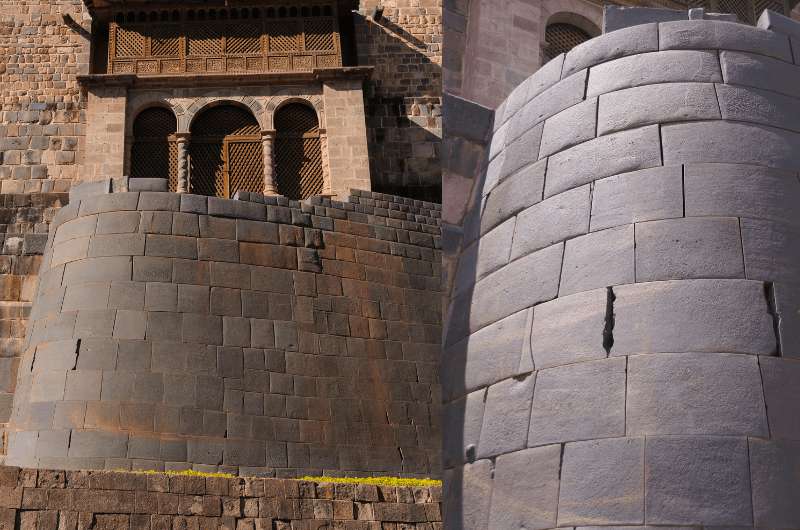
The base of the current church is made from Inca stones
I’ll put another shoutout to Inca stonework here: You’ve already read about how amazingly well-built Inca structures are, allowing them to withstand time and natural events. Well, the Spaniards took a whole century to build their cathedral on top of the Inca temple’s base. A few earthquakes later, the church was severely damaged while the Inca base was just sitting there, as perfect as ever, smirking condescendingly at the poor work of the Spaniards.
The Temple of the Sun is only one of many temples that used to stand in the Qorikancha site, but they are all in ruins now. There is a museum attached to the Temple of the Sun with artifacts from Inca history, like textiles, ceramics, paintings and musical instruments.
You’ll need at least an hour for the church and the museum. No gold-plated walls anymore, but you can still get a sense of its former glory.
Hotel tip: The Palacio del Inka is a Luxury Collection Hotel by Marriott that is located right by Qoricancha and I could see myself staying there if, say, the Hilton was fully booked or something.
6. San Cristobal viewpoint and church: Jaw-dropping panorama!

The best viewpoint in Cusco: San Cristobal
- Time spent here: 20 minutes
- Price: The viewpoint is free. You can use the ticket from the Cusco Cathedral to get in. It costs PEN 30 (USD 8) and includes entrance to Cusco Cathedral, San Blas Temple, the Archbishop’s Museum and San Cristobal Church.
- Pro tip: San Cristobal is the best viewpoint in Cusco! It’s way superior to Mirador de San Blas—there’s no wall, no stupid tourist locks on the railing (because there is no railing), the plaza is more spacious so you get a wider view of the city below (and from a better angle).
You can just skip the church and come here for the views of Cusco, because it is epic! Not just at sunset, but especially at sunset.
The red roofs of the city, Plaza de Armas in all its glory, and the mountains bordering it all in the back—it’s these perfect snapshots that make me giddy that I’m traveling like this and actually seeing these views with my own eyes.
The church itself is nice, with a massive golden alter and skylights that give the space a pleasant airiness. You can climb the bell tower, too. Nothing spectacular, which is why I say focus on the views of Cusco instead.
San Cristobal is located on a hill just 500 m (0.3 miles) to the north of Plaza de Armas, right under Sacsayhuaman.
Note: Everyone and their mom heads over to the San Blas neighborhood for views of Cusco. Yes, it is pretty, but no, it’s not better than San Cristobal. Go to San Blas if you’re into artsy vibes and local artisan shops; if you know me at all, you know it’s not what I personally look for.

7. Inca Rock Street: Where you’ll stare at rocks

Inca stones on Inca streets
- Time spent here: 30 minutes
- Price: Free
- Pro tip: Depending on the time of day you visit, you may need to stand slightly off to the side to avoid the glare and really capture the precision of the stonework of the 12-Angled Stone.
You’ll be trying to wrap your head around the perfectionist Inca architecture and amazing masonry skills on more than one occasion during your trip to Peru. Inca stone walls, built without mortar and standing just because of the ingenious way in which they were lodged together, have withstood the test of time and nature.
Two of those streets are Calle Hatunrumiyoc and Calle Inca Roca, which are one block away from each other. You can walk through and admire the Incas' work.
Seriously, these things look like they were renovated last year when in fact they’re centuries old! Just compare them to the newer stonework that is half falling apart in some sections. Gotta hand it to the Incas—truly impressive.
Many Spanish buildings were built on Inca stone bases, so you’ll be able to see a lot of Inca stones throughout the city, but in some streets it’s more apparent than others.

How many angles can you see? 12-Angled Stone in Cusco
What is the significance of the 12-Angled Stone?
On Calle Hatunrumiyoc, look for the famous 12-Angled Stone, a true pride of the locals. Legend says that it’s the one rock that holds up the entire palace. Remove it and bam! A pile of rocks. It’s located on the outside of the Archbishop’s Palace. You won’t have any trouble finding it—it’s where everyone is taking selfies and where guides will be offering to tell you about it for a small fee. You might even meet an alpaca that wants to take a picture with you. For a small fee, of course.

8. Sacsayhuaman Inca complex: The fortress that protected Cusco

Sacsayhuaman ruins
- Time spent here: 1.5 hours
- Opening hours : Open daily 7 am–5:30 pm
- Price: Tickets are not sold separately. You need the Cusco Tourist Ticket circuit 1
- Pro tip: Come here right before or after the San Cristobal viewpoint, they’re conveniently close to each other. And don’t underestimate the time you need to see it here—the place is massive!
Sacsayhuaman was a very important fortified Inca complex located on the northern side of Cusco, just a short distance away from the Plaza de Armas, right above the San Cristobal viewpoint, i.e. up a steep hill.
The fortress protected Cusco and it is where the Incas’ last stand took place before the Spaniards took over in Cusco.
The most fabulous part of the Inca site is the central plaza, which is where various ceremonies were likely held. It could fit thousands of people at once. The massive stones used in the walls surrounding the plaza are some of the largest used at any site in the Americas.
The Incas were known for their precise cutting and shaping of the individual stones that interlocked so perfectly that no mortar was ever used, but still their buildings would withstand any earthquake.

Most of the stones left at Sacsayhuaman are huge as they were the only ones the Spaniards couldn’t relocate to make churches out of them
Another amazing part of this feature is that thousands of men had to gather the stones from a quarry 20 kms away and bring them to the hill above Cusco.
After the Spaniards seized Cusco, they started taking Sacsayhuaman apart stone by stone. Those stones were used to build new structures in Cusco, like churches and governmental buildings. Only the largest stones stayed in Sacsayhuaman, since even the Spaniards couldn’t move them. So again, how in the world did the Incas do it?! These things measure 5 x 2.5 m!
Besides the Inca ruins, you can also catch amazing views of Cusco from Sacsayhuaman, and the sacred mountain Ausangate is visible in the distance, too.
9. Tambomachay, Qenco, Puka Pukara: Inca ruins right by Cusco

Here you can see Tambomachay, Qenco and Puka Pukara on a map
- Time spent here: 30 minutes each
- Opening hours: Open daily 9 am–6 pm (times may differ based on time of the year)
- Price: All are covered by Cusco Tourist Ticket circuit 1
- Pro tip: These are 3 separate Inca ruins very close to Cusco town, but you don’t need more than 2 hours to see all of them, including the drive there. Easy parking is available at each site.
I’ve grouped these three Inca ruins together because they’re all close to each other in northern Cusco. Qenco is right in the outskirts of Cusco while Tambomachay and Puka Pukara are a few kilometers outside of town, about 10 minutes by car or taxi.
They’re all conveniently on Cusco Tourist Ticket circuit 1 which is only valid for one day, so you have no choice but to group them together during one outing. For more information about the Cusco Tourist Ticket, check out my Cusco itinerary for 3 days.
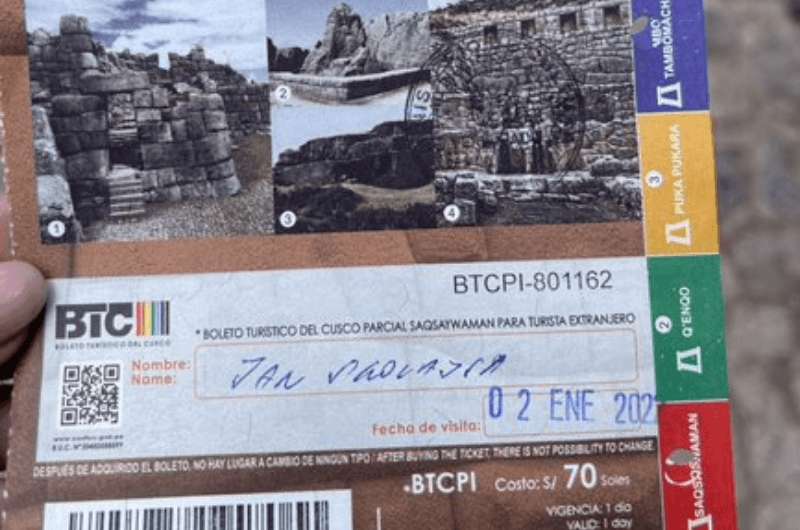
My Cusco Tourist Ticket
In Qenco, you’ll see great examples of megalithic stone cutting and shaping, one of the Incas’ specialties. This is where sacrifices and mummifications likely took place, and you’ll be able to walk between the high walls and into “caves” to see some alters.
It sounds cooler than it actually was. Not bad, but crowded and not very big, so you’ll be ready to move on shortly. There isn’t much written on the signs, so read up before you go or take a guide. Otherwise, you’re just looking at a bunch of rocks.
There are great views of Cusco from Qenco, so that’s a bonus.

Tambomachay
Tambomachay
Tambomachay is a water worship center, or perhaps an Inca spa, who knows. You’ll learn, if you didn’t know this already, that the Incas were great at irrigation in general and controlling the flow of water sometimes over huge distances.
There are three stoned terraces at Tambomachay that are built over natural springs. The water from the springs would feed the canals, aqueducts and waterfalls that were built into the terraces. They still flow today.
One kilometer (0.6 miles) away from Tambomachay is Puka Pukara, the Inca fortress that served as an entry checkpoint into Cusco.

Puka Pukara ruins
At sunset, the walls look red, which is where the name, which means “Red Fortress” in Quechua, comes from.
There isn’t much except the walls left at Puka Pukara, so you won’t need too much time there, either, but the views of the surrounding mountains and valleys are also something to be appreciated.
You won’t find any information at Puka Pukara besides some basics, so again, read up before you go or get a guide. There are horseback tours available for example. Could be an interesting twist on it for those of you not allergic to horses like me.
10. Coca Museum: Where they teach you how cocaine is made

Coca Museum (blink and you’ll miss the tiny entrance)
- Time spent here: 45 minutes
- Opening hours: Open daily 10 am–6 pm
- Price: PEN 10 (USD 2.60)
- Pro tip: DON’T buy souvenirs for family back home at the coca museum’s souvenir shop. You’ll have to throw all your gifts all away at the airport when you’re leaving Cusco. I know, because I did exactly that. Apparently, coca isn’t a great thing to try to export.
This is a little museum about Peru’s famous plant, coca. You’ll need to be really looking for it in order to notice the entrance in between the tourist shops displaying colorful souvenirs.
You’ll see and most likely try coca in the form of either a tea or a sweet treat while in Cusco. First of all because it feels forbidden and exciting, second of all because it helps with altitude sickness.
The Coca Museum does a good job explaining the history and evolution of the coca leaf, including how the Incas used it, its properties and health benefits, like that it’s why the indigenous tribes had nice, white teeth. Of course, you’ll also learn about cocaine, including how to make it, which was a bit strange.
Overall, an enjoyable experience that ends in the gift shop. Stock up on coca everything! But don’t bring any coca goodies home as gifts, because it is illegal pretty much everywhere on the planet. We bought presents for everyone at home, only to dump them all in Lima because oh, we can’t actually take them out of the country. If you buy stuff, you’ll need to use/eat/drink it while you’re still in Peru.

Coca is easily accessible in Peru, but remember what happens in Peru, stays in Peru (because you’ll have to throw it all away at the airport)
What are the effects of coca tea? Kind of like coffee, but better
Coca tea has mild stimulant effects similar to coffee. It can help increase energy, reduce fatigue, and improve mental alertness. Coca tea is also widely known for alleviating altitude sickness symptoms, such as headaches, nausea, and shortness of breath—making it a popular drink in high-altitude areas like Cusco. While it’s a traditional Andean remedy, coca tea is not psychoactive like cocaine, so don't expect a wild ride—just a gentle energy boost and some serious altitude relief.
Note: But do note that if you taste anything coca-related, you will test positive for cocaine on drug tests.
The best day trips from Cusco: From Sacred Valley to Machu Picchu
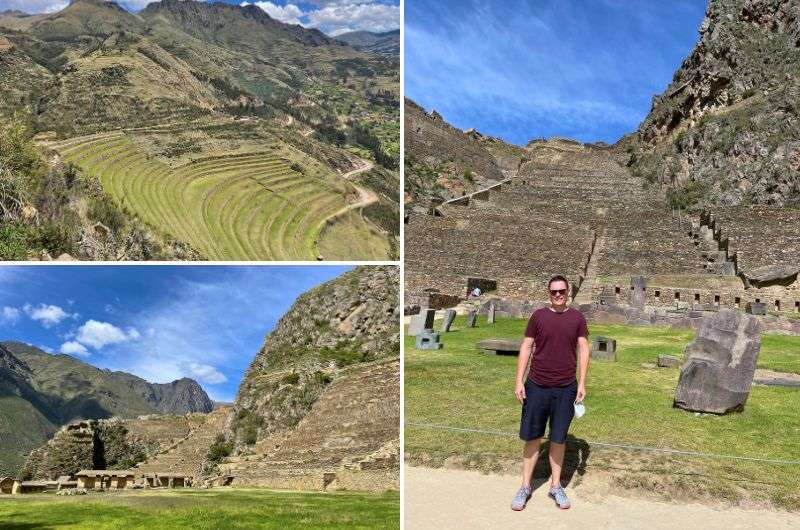
One of the best day trips from Cusco is through Sacred Valley
One of the perks of staying in Cusco is its proximity to incredible day trips. Cusco region is like the trip that keeps on tripping! From ancient Inca ruins to breathtaking natural wonders, here are some of the best options:
- Moray & Maras: Explore the Inca experimental agricultural terraces of Moray and the super-interesting salt mines of Maras. A quick stop on your Sacred Valley day trip. I have an entire guide on Moray and Maras!
- Pisac: This was one of my ultimate favorite places in Sacred Valley. Visit the impressive Pisac ruins and the town’s vibrant market. This trip combines history with local culture, plus unbeatable views of the Sacred Valley.
- Rainbow Mountain: A challenging but rewarding trek that takes you to the multi-colored slopes of Rainbow Mountain, sitting at over 5,000 m (16,400 ft)! It's one of the most surreal landscapes in the region, even if it isn’t as colorful as Instagram wants you to believe. Few people know there are actually 3 different hikes you can choose from to get to Rainbow Mountain. Read my Rainbow Mountain guide for all the details on those (and about how sick I got up there).
- Humantay Lake: A stunning turquoise glacial lake nestled in the mountains. It’s almost annoyingly beautiful. The hike up is moderate, but the views are absolutely worth the effort.
- Machu Picchu: While not a typical day trip due to complex logistics, visiting Machu Picchu is the crown jewel of any Cusco adventure. Check out my full Machu Picchu guide on how to get there and tips for the best Machu Picchu circuit(s).

Machu Picchu is more suited as an overnight trip from Cusco
I have written extensively about every one of these places in separate articles, so hop on over there if you want further info. These guides will give you all the insider tips and must-see spots!


Best restaurants in Cusco: Pizza or steak?
Cusco is set in the most gorgeous scenery, and it offers so many things to see, but it is touristy enough for there to be a great selection of restaurants too, which is always a huge bonus point for me.
Uchu Peruvian Steakhouse
Uchu Peruvian Steakhouse was a totally random restaurant choice for me. There’s a nice little garden in front with lots of flowers and a few tables which caught my attention. Uchu does the best chicken I’ve ever had. I’m salivating now just thinking about it. I had the peruano kebab and instantly fell in love.
Organika
Organika is more a quality-over-quantity-type place. You know everything here is made out of fresh ingredients—they have their own produce garden in the Sacred Valley! If you want healthy and organic, this is the spot for you. I had an interesting pizza, and I use the word “interesting” because it wasn’t anything like the Italian original. Or anything you’d expect to eat in Cusco. It was…fluffy! I also tasted the arugula tiramisu, which was… not better than the original, but it was… also interesting.
Garden Grille @ the Hilton Garden Inn
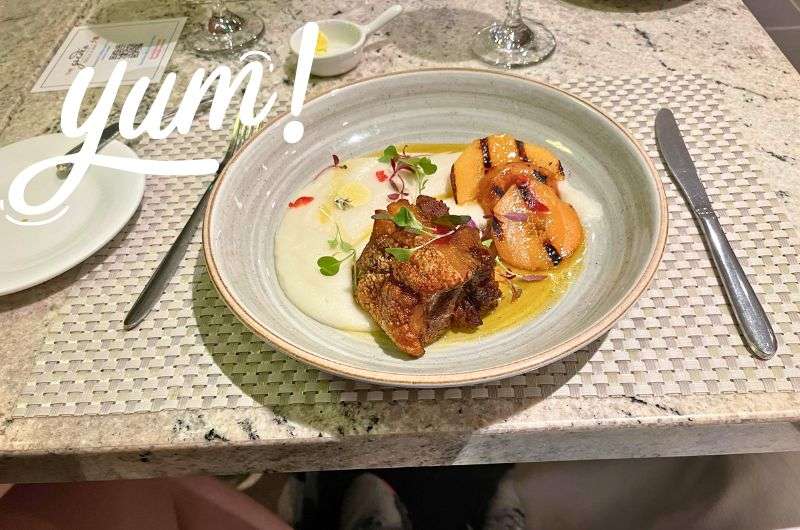
I absolutely loved the food at the Garden Grille!
I’ve already mentioned how great not just the food and drinks are at the Garden Grille, but also how fantastic the views are from the restaurant. It’s up on a hill, so it’s like you’re eating and sightseeing at the same time. The fact that your bed is just a few floors away is also a big bonus.

Cusco weather: Wet and warm or dry and cold
- Dry season: May to August
- Rainy season: November to March
- Most popular months for tourists: June to September
Since Peru’s so close to the equator, distinguishing the seasons isn’t as important as knowing when the dry and wet months are. The temperatures in Cusco are fairly constant year-round at about 20°C (68°F) during the day. From November to March you’re looking at rainy season. But when there’s no rain, in May to August, you get chillier nights, with nighttime temps dropping below freezing.
Winter vs summer: In Peru, the seasons are the other way around compared to the northern hemisphere—summer is December to February and winter is June to August.
Pro tip: No matter when you visit, remember that even if you’re not feeling the heat, your skin will be feeling the sun, so use SPF protection. You are, after all, at least a couple kilometers closer to the sun than when you’re at home!


This is me walking around Cusco with a good layer of SPF on
How high is Cusco? Enough to make your head spin!
- Cusco’s altitude: 3,400 m (11,000 ft)
- Lima’s altitude: 150 m (490 ft)
- Machu Picchu’s altitude: 2,430 m (7,970 ft)
- Altitude sickness: can start at 2,500 m (8,200 ft), more noticeable at 3,000+ m (9,800+ ft)
- Common symptoms: headaches, dizziness, shortness of breath
On the downside of all of Cusco’s natural beauty is the fact that it is in a crazy high altitude, making it hard for us lowland humans to exist there without some side effects. The thinner air definitely makes you feel things you don’t want to be feeling, like fatigue, headaches, and nausea. I know I felt all of those, and I thought I was a tough guy!
Pro tip: Two days in Cusco is not enough for your body to be ready to head out on a Rainbow Mountain day trip and don’t even look at Ausangate unless you’ve been closer to the clouds for 4–5 days prior.
How to acclimatize
- Take it easy for the first 1-2 days: Avoid strenuous activities when you first arrive and start to explore Cusco.
- Stay hydrated: Drink plenty of water. Dehydration can worsen altitude sickness.
- Avoid alcohol and heavy meals: Alcohol and large, rich meals (and lots of meat) can make symptoms worse, so stick to light, healthy foods. Flower pizza it is (see above restaurant tips)!
- Coca tea: Locals (and now I) swear by coca tea, a traditional Andean remedy that helps ease altitude sickness symptoms.
- Gradual ascent: Plan your trip so that you gradually ascend to higher altitudes rather than going straight to a high point. Tip: Go to Arequipa first, not straight to Cusco from Lima.
- Medication: Consider taking altitude sickness prevention medication like acetazolamide (Diamox), but consult your doctor before using it.
- Listen to your body: If symptoms worsen, take breaks, rest, and descend to a lower altitude if necessary. Don’t push through severe symptoms.
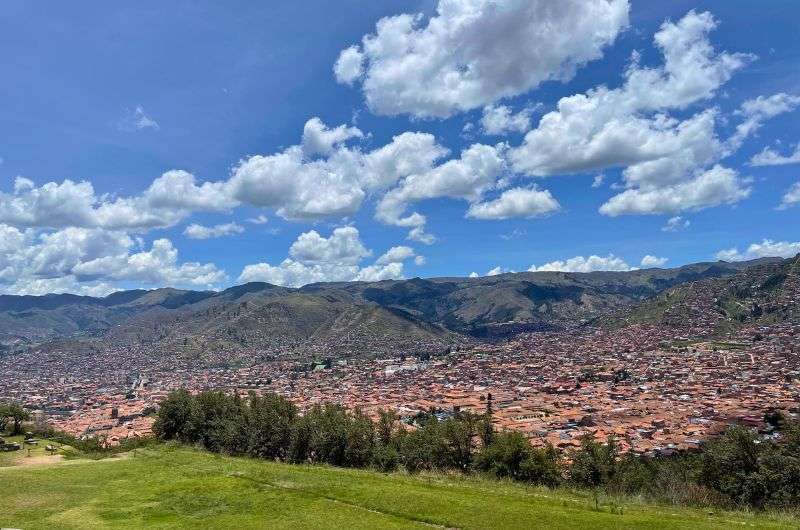
The city of Cusco is very high up. It may take you a few days to get used to the altitude
Did you know?
Machu Picchu, which appears in photos to be in the highest of heights, is a full 1,000 m (3,300 ft) lower than Cusco city!
Is Cusco safe? I thought so
My feeling was that yes, Cusco is safe. I don’t usually go wandering in side alleys at 2 am with a big camera around my neck, so I can’t testify to that, but for the standard tourist stuff, absolutely. Cusco felt safe to me.
Plaza de Armas especially has a constant police presence with security cameras keeping any bad guy activity at bay 24/7.
The only time I felt a little uneasy during our time in Peru was in the non-central parts of the otherwise fabulous Arequipa, and the most dangerous thing I did in Peru by far was driving in Lima. Maniacs.

Basic facts about Cusco, the legacy of the Inca Empire
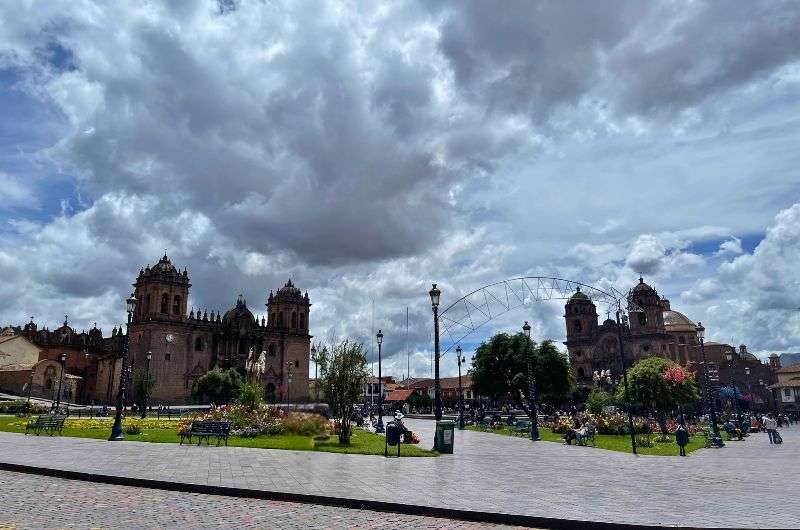
Cusco is the former capital of the Inca Empire
- Oldest continuously inhabited city in the Americas: People have lived in Cusco for over 3,000 years!
- Cusco’s location: Southern Peru in the Andes Mountains.
- Proximity to Sacred Valley: Cusco is just southeast of the Sacred Valley, serving as the gateway to exploring its Inca ruins, picturesque villages, and stunning landscapes. It's only a 15- to 60-minute drive to various parts of the valley.
- Cusco’s population: Approximately 500,000.
- Inca Empire capital (13th to 16th century): The heart of the Inca civilization until 1533, when the Spanish conquistadors, led by Francisco Pizarro, took over.
- Spanish influence: The Spanish conquest also brought grapes and empanadas to Peru–thank them for Pisco! Pisco sours are a staple to any Peru visit (read more about food and drinks in Peru).
- Inca heritage: Cusco, the ancient Inca capital, retains more of its Inca roots than any other Peruvian city. Inca history is everywhere, from museums to the city’s streets to the name of every souvenir shop and cafe.
- Gateway to Machu Picchu: Cusco is the main jumping-off point for trips to the famous Inca city. Whether you’re hiking the Inca Trail or taking the train, you'll inevitably start in Cusco.
You might also be interested in reading:
I've put together a ton of information about visiting Peru. Not only destination guides and itineraries, but also travel tips and tricks that I've learned the only way you can—by having traveled to Peru myself.
Read these before you go so you can enjoy your vacation to the fullest:
- All You Need to Know Before Traveling to Peru
- The Best 3-Day Cusco Itinerary
- A 2-Week Peru Itinerary: A Day-By-Day Trip Plan
- Best Places in Peru
- Driving in Peru
- Best Restaurants in Peru
- Christmas and New Year’s in Peru
This post contains affiliate links. I earn a small commission if you make bookings through my links, at no additional cost to you. Thank you for your support!
A list of the top things to see in Cusco: The must-sees of Cusco
Cusco map of things to see: It’s all very close together
My top tips for visiting Cusco:
Where to stay in Cusco? Choose an international hotel chain
1. Inca Museum (Museo Inka): All about Inca culture
2. Museum of Pre-Columbian Art: The fascinating cultures of central Peru
3. Plaza de Armas: The place life in Cusco centers around
4. Cusco Cathedral: The one with Jesus eating a guinea pig
5. Qoricancha: Ancient temple dedicated to Sun God Inti
6. San Cristobal viewpoint and church: Jaw-dropping panorama!
7. Inca Rock Street: Where you’ll stare at rocks
8. Sacsayhuaman Inca complex: The fortress that protected Cusco
9. Tambomachay, Qenco, Puka Pukara: Inca ruins right by Cusco
10. Coca Museum: Where they teach you how cocaine is made
The best day trips from Cusco: From Sacred Valley to Machu Picchu
Best restaurants in Cusco: Pizza or steak?
Cusco weather: Wet and warm or dry and cold
How high is Cusco? Enough to make your head spin!




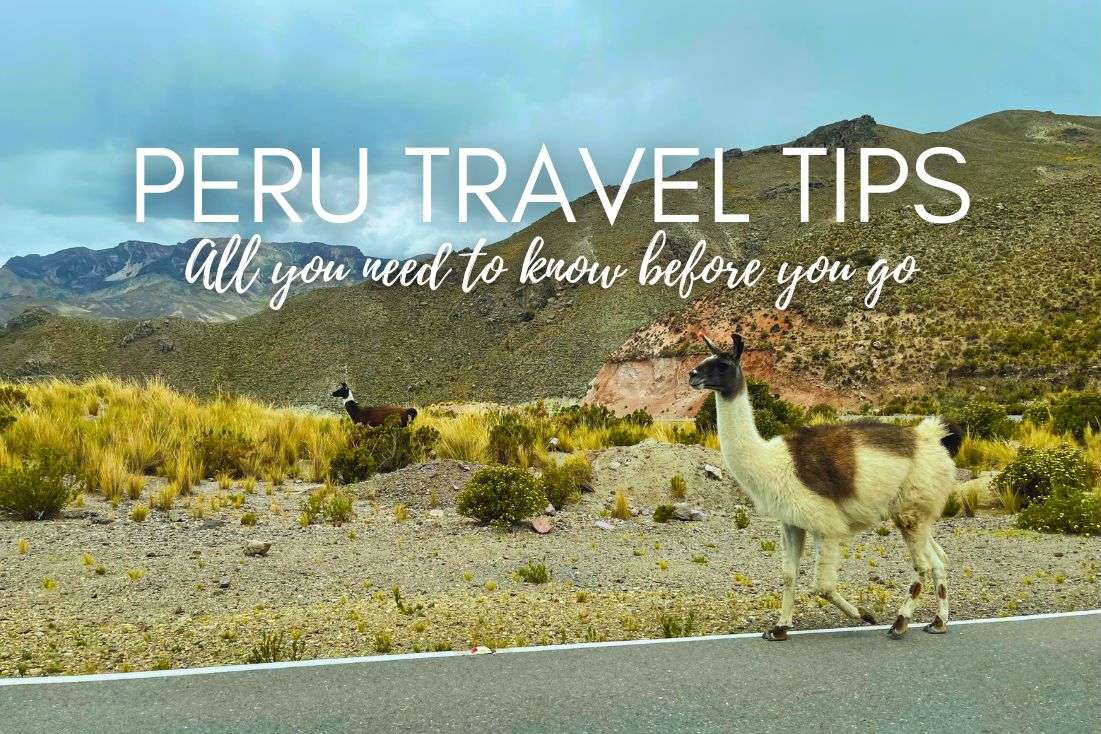





Comments | Thoughts? Give us a shout!